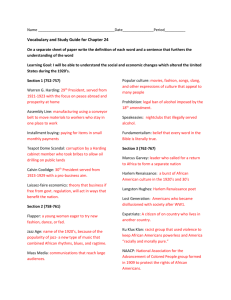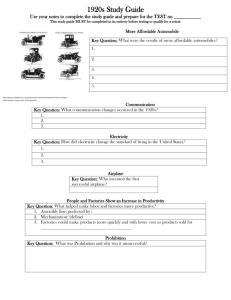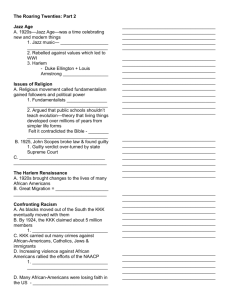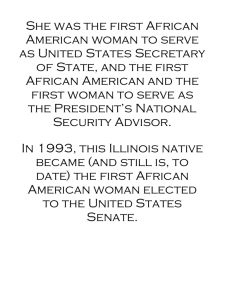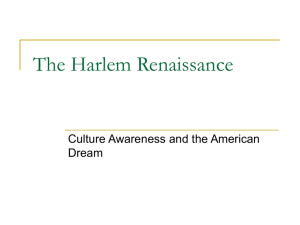Harlem renaissance literary time period
advertisement
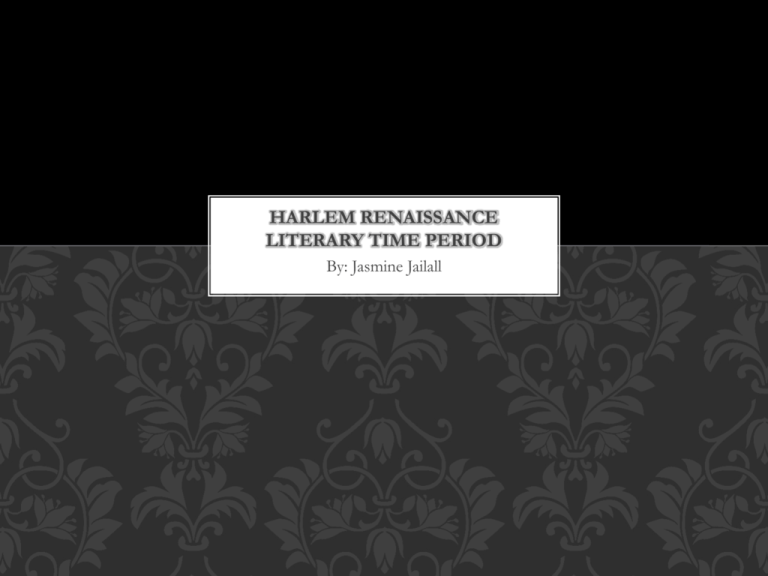
HARLEM RENAISSANCE LITERARY TIME PERIOD By: Jasmine Jailall INTRODUCTION Also known as the New Negro Movement, the Harlem Renaissance began after the American Civil War Great Migration occurred when African Americans moved from the South to the North. Harlem became the brightest place. It was filled with musicians, artists and writers. Harlem later became known as "the capital of Black America” This time period gave the African American people a sense of pride in their culture; they felt as if no one can stop them. WHAT IS THE HARLEM RENAISSANCE LITERARY TIME PERIOD? During this literary period, African Americans used their culture to redefine the African American literature The Harlem Renaissance literary time period began with a series of literary discussions that later led to many famous writers. COTTON CLUB The Cotton Club was a famous Jazz music night club located in Harlem, New York. This was a white-only club, however featured many famous African American entertainers. The Cotton Club eventually has a section for African Americans only, and they had separate entertainment for them. POLITICAL CONDITIONS African Americans were given the right to vote. The two major political figures during this time was Marcus Garvey and W.E.B. Dubois. MARCUS GARVEY He founded the Universal Negro Improvement Association and he also served as the president. Also opened several business to promote a separate black nation W.E.B. DUBOIS the first African American to graduate from Harvard University Cofounder of the National Association for the Advancement of Colored People (NAACP). Not only was Dubois a politician, but he was also a writer. RELIGIOUS CONDITIONS Many new ideas were formed about how to carry on religious beliefs, such as mega-type churches, sect/cult approaches, and religious nationalists. First Pan African Congress, which created a gateway to African unity and spiritual values. Many new thinking patterns and different creative patterns were formed that were controversy to previous beliefs. CHARLES A. TINDLEY First African American to compose and publish hymns. THOMAS A. DORSEY Known as the "Father of Gospel" because of his traditional style Gospel Music. ARTISTIC CONDITIONS Art played a key role in showcasing the Harlem Renaissance. Artists were able to show the African American culture through their paintings with great emotion. Each art work has a story behind it and it varies from each artist. WILLIAM H. JOHNSON This artist is known for his style of colorful and neofolk paintings. Won an Harmon award for his art work. His paintings are very personal because they involve his family and friends and his life in Florence, South Carolina. SARGENT CLAUDE JOHNSON This artist is known for his wonderful sculptures because they represent the beauty of the African American people. Because of his wonderful work, he was later known as one of the leading sculptors during the Harlem Renaissance. LANGSTON HUGHES As a young child, Hughes was named the class poet, even though he never actually written any poems. Published " The Weary Blues", which won him his first prize in 1925. His writings always shows his pride towards his African heritage. ZORA NEALE HURSTON Her writing started with college publication and then later she began writing magazines, newspapers and also entering into writing contests. The peak of Hurston's works was during the 1930's through the 1940's when she published four novels and an autobiography. However, her career took a turn for the worse, when she was charged for molesting a ten year old boy. Later died because she fell into depression and had a stroke. “THE WEARY BLUES” This poem is by Langston Hughes. This poem takes places in Harlem, where the speaker hears a blues musician playing music. This poem makes the reader feel a sense of calmness because he wants you to connect with the blues musician. “IF WE MUST DIE” This poem written by Claude McKay. His reason for writing this poem was to tell his people to stand up for what is right and fight back. LITERARY INFLUENCE The Literature of this time period showed how bad racial segregation really was. Marcus Garvey emphasized a new philosophy for African Americans known as the "Back to Africa" movement.. The ideas surrounding the "Back to Africa" movement established a new sense of pride and planted the foundation for advancements during the Harlem Renaissance. Many of these famous and known artists and civil rights activists had a lot to do with the political, social, and religious reforms during this time as well BACK TO AFRICA MOVEMENT Also known as the Colonization Movement. The ideas surrounding the "Back to Africa" movement established a new sense of pride and planted the foundation for advancements during the Harlem Renaissance. WORK CITED Harlem Renaissance". Bio True Story.Web.10 May 2012 http://www.biography.com/tv/classroom/harlem-renaissance "Politics Issues". Harlem Renaissance Multimedia Resource. Web.10 may 2012http://www.jcu.edu/harlem/Politics/Page_1.htm "W.E.B. Du Bois." Bio True Story. 2012. Web 14 May 2012 http://www.biography.com/people/web-du-bois-9279924 Meltzer, Milton. "Langston Hughes: A Biography". Encyclopedia of World History. New York: Crowell, 1968.Web.14 May 2012http://www.notablebiographies.com/Ho-Jo/Hughes-Langston.html Denise Low & T.F. Pecore Weso. "Langston Hughes Biography". Kansas History. 2004. Web. 15 May 2012 <http://www.kansasheritage.org/crossingboundaries/page6e1.html> WORK CITED CONTINUED "Biography Of Zora Neale Hurston". Grade Saver.Web. 15 May 2012http://www.gradesaver.com/author/zora-neale-hurston/ "African American Writers and Poets".Harlem Renaissance. Web. 15 May 2012 http://www.uncp.edu/home/canada/work/markport/lit/introlit/harlem2.htm "Cotton Club". Wikipedia. Web. 16 May 2012 http://en.wikipedia.org/wiki/Cotton_Club Johnson, Sargent Claude". Cartage. Web. 16 May 2012 http://www.cartage.org.lb/en/themes/Biographies/MainBiographies/J/JohnsonS/Johnson.htm Richard J. Powell. "The Harlem Renaissance". African American Art. Web. 16 May 2012 http://www.artlex.com/ArtLex/a/african_american_4.html "The Weary Blues". Web. 16 May 2012 <http://cai.ucdavis.edu/uccp/workingweary.html>

